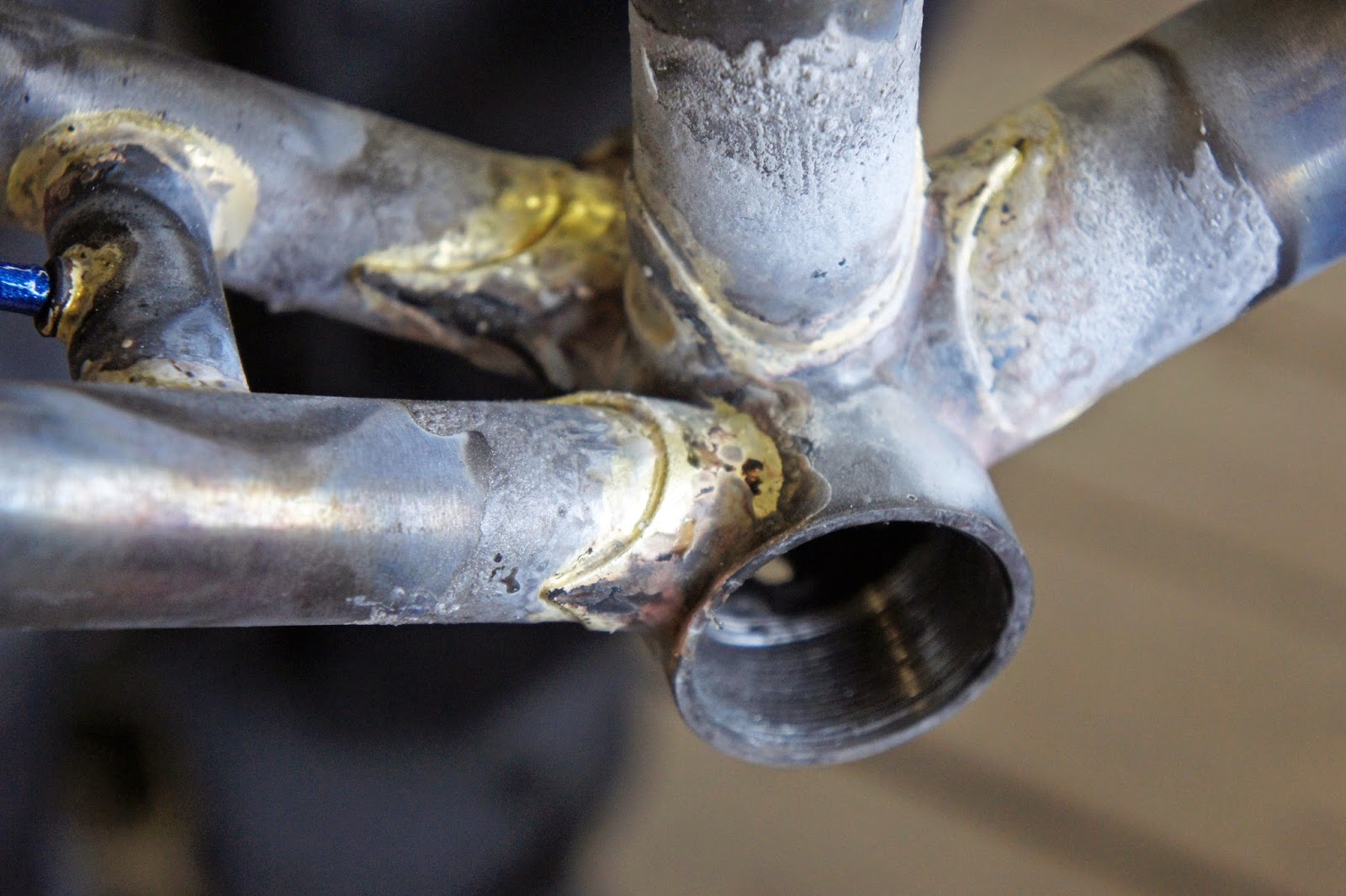In swept the heat wave, so Holdsworth emerged from prolonged hibernation
for some midsummer fun. Fresh gripper paste on its Tifosi carbon post,
Specialized perch further forward, 125psi into the tyres and a quick beeswax
furniture polish blow-over later, we hammering along the sweeping back doubles
at 25mph plus.
Carbon fork, post, large flange hubs, CNC machined drive sprockets and stout
KMC Onyx chain certainly help but despite being 60 years old, those plain gauge
531 tubes still deliver a responsive, rewarding ride.
This intoxicating serenity was rudely interrupted by the sudden and
unexpected and almost comedic jettisoning of its newly fitted Altura wedge pack-straight into deep, roadside undergrowth. Closer inspection revealed
the sprung Klick fix mechanism had gone the way of elderly underwear elastic
and wouldn’t engage convincingly with the resin post mount.
This isn’t a reflection on the otherwise superb bag and said failure
would be covered under warrantee. However, in my experience, sprung mechanisms
per se (most notably smart heads on pumps and standalone pressure gauges) prove
phenomenally reliable, serving us faithfully until they suffer sudden
cataclysmic implosion.
Momentary, slightly indigent frustration was swept aside by risky pragmatism.
Resting my beloved fixer against a five bar gate, I slipped mini pump,
15mm wrench, tyre levers and glue-less patches into jersey pockets, hid the
stricken tool caddy deeper within the undergrowth and thundered on.
Thankfully the puncture fairy smiled down upon me for the remaining twelve mile loop, though having re-entered the zone where physical exertion unleashes enhanced mental processing, the most convenient method of carrying it home still eluded me.
The light bulb moment struck while descending at 46mph. I decided simply to shove the stricken bag beneath my jersey for the remaining three miles. Admittedly, some folks (including a group of reservist fire fighters) stared in wide wonder at my newly acquired pectoral mass that could almost pass for backstreet breast implants.
Thankfully the shame was only fleeting given I was travelling at 18mph and quickly substituted with my own subversive sniggering...
Back in the bat cave, the most obvious solution appeared in the guise of
this B’Twin 700 bottle caddy. Ride essentials ported across and mini pump
riding shotgun on the bottle cage, it’s an unobtrusive, cheap as chips
solution.
Obviously, this means I either opt for another SKS cage mount adaptor, which
might look a little Lego-like but seem superbly engineered, a hydration pack,
or a less convenient Tri type-know there’s one in my bodge box doing nowt.
Talking of frames, the world of traditional frame building continues to
contract. Yes, there will always be a market for bespoke steel framesets but
small scale craftspeople are either working for specialist brands, designing
and building higher end production bikes, or adopting a much broader retail
model.
That’s not to say its romantic allure is waning the cycling publics’
consciousness-forums are wilting under the heat of people waxing lyrically
about intricate lug work and impeccable brazing (although the former is also a
clever way of hiding a multitude of flaws).
Shrewd builders with sufficient space (not to mention; patience) have
tapped into this phenomenon, offering week long courses whereby keen
enthusiasts can build their own frameset from one of the more user friendly
Cro-molys-Reynolds 525 being a deservedly popular choice given the bewildering
array of sizes and wall thicknesses.
Presented with such an opportunity, I would be delighted to enrol and
hopefully come away, pleased as punch with the fruits of my labour but with no
commercial pretensions whatsoever.
Then of course, interest in older frames has also mushroomed with a more
generic retro revival encompassing “classic” cars, motorcycles, scooters, not
forgetting clothing. During my teens, a classmate and self-appointed fashion
guru made an unusually insightful remark. Chinos had just swept back in along
with Flat tops and other styles with a 1950s flavour and he commented that
fashion had reached the point where it couldn’t progress any further, so was
and would continue borrowing from the past.
Frame fit pumps are also starting to gain a niche following too. Ultra
efficient models capable of delivering 120psi are still very relevant. I still
mourn a ¾ length resin Specialized model that was so cruelly nudged from its
bracket and crushed beneath the wheels of an approaching double decker bus
although I’ve gotta admit, Co2 cartridges are worth their weight in gold by the
roadside.
Right, well you’ll excuse me while I do some forward planning for Seven
Day Cyclist (www.sevendaycyclist.co.uk) and continue
building my photographic website. Continuous development is crucial in a
perpetually changing world, one that seemingly never sleeps.






















